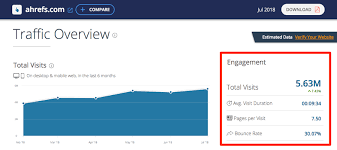Understanding Website Traffic Analysis
Website traffic analysis is a crucial aspect of any online business or organisation. It involves the process of monitoring and analysing the behaviour of visitors to a website, providing valuable insights that can inform decision-making and improve overall performance.
Why is Website Traffic Analysis Important?
By tracking website traffic, businesses can gain a better understanding of their audience, including where visitors are coming from, which pages they are viewing, how long they are staying on the site, and what actions they are taking. This data is essential for measuring the effectiveness of marketing campaigns, identifying areas for improvement, and ultimately driving growth.
Key Metrics in Website Traffic Analysis
Some key metrics that are commonly analysed in website traffic analysis include:
- Page Views: The total number of pages viewed by visitors.
- Unique Visitors: The number of distinct individuals visiting the site.
- Bounce Rate: The percentage of visitors who navigate away from the site after viewing only one page.
- Conversion Rate: The percentage of visitors who complete a desired action, such as making a purchase or signing up for a newsletter.
- Traffic Sources: Where visitors are coming from, such as search engines, social media platforms, or direct traffic.
Tools for Website Traffic Analysis
There are various tools available to help businesses analyse website traffic effectively. Popular tools include Google Analytics, which provides detailed insights into visitor behaviour and performance metrics. Other tools like SEMrush and Moz offer additional features for competitive analysis and SEO optimisation.
The Benefits of Website Traffic Analysis
By regularly analysing website traffic data, businesses can:
- Gain insights into customer behaviour and preferences.
- Identify strengths and weaknesses in their online presence.
- Optimise marketing strategies to reach target audiences more effectively.
- Improve user experience and increase conversion rates.
- Make data-driven decisions to drive business growth.
In conclusion, website traffic analysis plays a vital role in helping businesses understand their online performance and make informed decisions to achieve success in the digital world. By leveraging the insights gained from analysing website traffic data, businesses can stay competitive and continuously improve their online presence.
Essential Tips for Effective Website Traffic Analysis
- Use Google Analytics to track website traffic.
- Monitor key metrics such as pageviews, sessions, and bounce rate.
- Set up goals in Google Analytics to track conversions.
- Analyse referral sources to understand where your traffic is coming from.
- Regularly review and compare traffic data to identify trends and patterns.
- Utilise tools like heatmaps and A/B testing for deeper insights into user behaviour.
Use Google Analytics to track website traffic.
Utilising Google Analytics to track website traffic is a valuable tip for businesses looking to gain in-depth insights into their online performance. By implementing this powerful tool, businesses can monitor key metrics such as page views, bounce rates, and conversion rates, enabling them to make informed decisions based on real data. Google Analytics provides a comprehensive overview of visitor behaviour and traffic sources, helping businesses understand their audience better and optimise their online strategies for improved results.
Monitor key metrics such as pageviews, sessions, and bounce rate.
Monitoring key metrics such as pageviews, sessions, and bounce rate is essential for gaining valuable insights into website performance. Pageviews indicate the total number of pages viewed by visitors, sessions represent individual visits to the site, and the bounce rate reflects the percentage of visitors who leave after viewing only one page. By closely monitoring these metrics, businesses can assess user engagement, identify areas for improvement in content or user experience, and ultimately enhance their website to drive higher levels of traffic and conversions.
Set up goals in Google Analytics to track conversions.
Setting up goals in Google Analytics to track conversions is a crucial tip for effective website traffic analysis. By defining specific goals, such as completing a purchase, signing up for a newsletter, or filling out a contact form, businesses can measure the success of their online activities and understand how visitors are engaging with their site. Tracking conversions not only provides valuable insights into user behaviour but also helps businesses optimise their marketing strategies and improve overall website performance. With clear goals in place, businesses can make data-driven decisions to enhance user experience and drive growth.
Analyse referral sources to understand where your traffic is coming from.
Analysing referral sources is a valuable tip in website traffic analysis as it provides crucial insights into the origins of your website visitors. By understanding where your traffic is coming from, whether it’s from search engines, social media platforms, or other websites, you can tailor your marketing strategies to target those channels effectively. This information allows you to focus your efforts on high-performing referral sources and optimise your online presence to attract more relevant traffic, ultimately leading to increased engagement and conversions on your website.
Regularly review and compare traffic data to identify trends and patterns.
To effectively monitor website performance and make informed decisions, it is crucial to regularly review and compare traffic data to identify trends and patterns. By analysing traffic data over time, businesses can gain valuable insights into visitor behaviour, popular content, and the effectiveness of marketing efforts. This proactive approach allows businesses to adapt strategies, optimise user experience, and capitalise on emerging opportunities to enhance their online presence and drive growth. Regularly reviewing and comparing traffic data is key to staying competitive in the dynamic digital landscape.
Utilise tools like heatmaps and A/B testing for deeper insights into user behaviour.
To gain deeper insights into user behaviour and enhance website performance, it is recommended to utilise tools such as heatmaps and A/B testing. Heatmaps provide visual representations of user interactions on a webpage, highlighting areas of high activity and areas that may need improvement. A/B testing, on the other hand, allows for the comparison of two versions of a webpage to determine which one performs better in terms of user engagement and conversions. By leveraging these tools in website traffic analysis, businesses can make data-driven decisions to optimise their online presence and create a more user-friendly experience for visitors.






